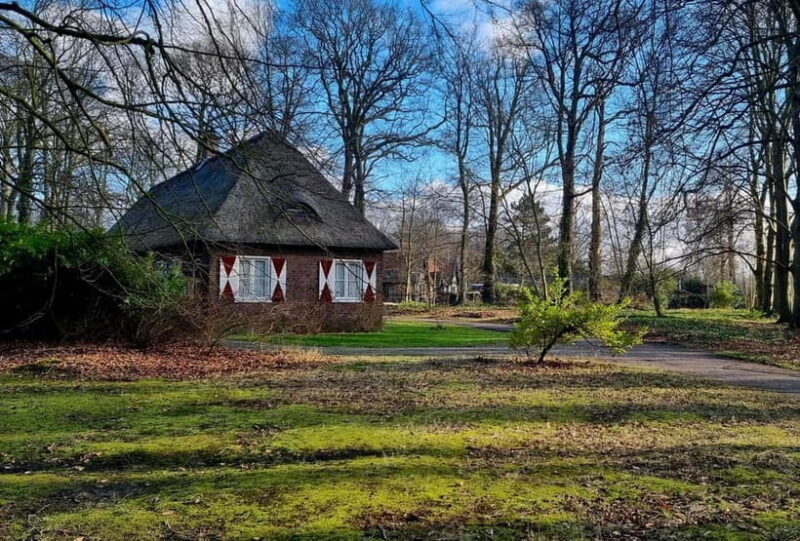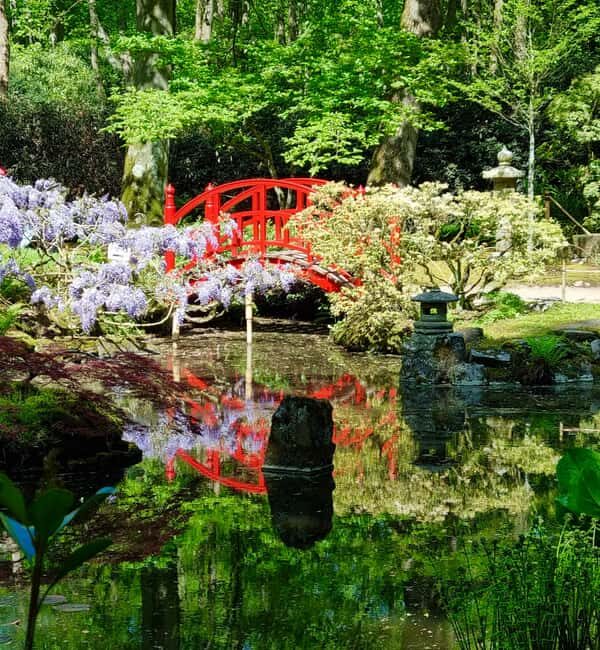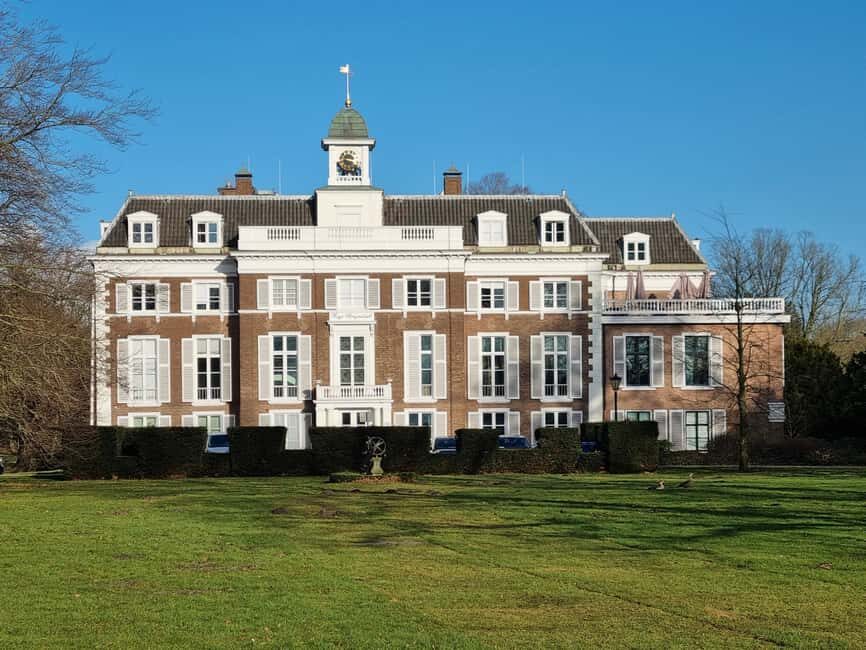Exploring Clingendael’s Japanese Garden: A Hidden Gem in South Holland
If you’re visiting the Netherlands and have a soft spot for gardens and history, the Clingendael estate offers a peaceful retreat filled with scenic beauty and fascinating stories. For just $9 per person, you can wander through a landscape that dates back to the 16th century, culminating in the enchanting Japanese garden—a highlight that opens only a few weeks each spring and autumn. Your guide, often a knowledgeable local, will lead you through this historic estate, sharing stories about its residents, architecture, and hidden corners, making the visit both educational and visually stunning.
What we love most about this experience is the serene landscape of meadows, old farm buildings, and quaint cottages, which make the estate feel like stepping into a living postcard. Plus, the Japanese garden itself is a masterclass in design—laid out in the early 20th century by Baroness van Brienen, it offers a tranquil, meticulously curated setting that truly feels like a world away.
One thing to consider is that the tour is conducted primarily in Dutch, so non-Dutch speakers might want to prepare for some language barriers or consider bringing a translation app. Also, since the Japanese garden is only open during specific seasons, timing your visit is key to experiencing its full beauty. This tour suits travelers who enjoy history, nature, and a touch of Japanese aesthetic in a quiet, authentic Dutch setting.
Key Points
- Historic Estate: Clingendael dates back to 1544, offering a deep sense of Dutch heritage.
- Beautiful Gardens: The estate features scenic meadows, parks, and a famous Japanese garden.
- Guided Experience: Knowledgeable guides share stories about the estate, its residents, and its architecture.
- Limited Seasonal Access: The Japanese garden is open only in spring and autumn, making timing important.
- Value for Money: At $9, this is an affordable way to enjoy a peaceful walk and learn some history.
- Designed for Culture Enthusiasts: Ideal for those who appreciate gardens, architecture, and authentic stories.
Discovering Clingendael: A Perfect Blend of Nature and History

When we first arrived at Clingendael, we were struck by how the estate’s landscape seamlessly combines Dutch rural charm with historical grandeur. The estate, located on the border of Wassenaar and The Hague, covers a sprawling area with meadows, ancient trees, and a handful of cottages—elements that conjure a sense of stepping back in time. The property’s roots stretch back to the mid-1500s, and walking through it feels like leafing through a living book of Dutch history.
The estate’s main attraction is the Japanese garden, which is a carefully designed oasis that embodies tranquility. Laid out in the early 20th century by Baroness van Brienen—also known as Freule Daisy—it reflects a Japanese aesthetic that’s rare in the Netherlands. During our visit, we loved the way the garden’s pathways, small bridges, and meticulously trimmed bushes create a peaceful, almost meditative environment. The fact that it is only open for a few weeks each year means visitors often consider it a special treat, and rightly so.
Planning more time in The Hague? We've covered other experiences worth considering.
The Guided Tour Experience
The tour, led by a local guide, offers more than just a stroll. With a skillful storyteller, we learned about the estate’s history, the families who lived there, and the German occupation during WWII, when Seyss-Inquart stayed in the country house. This historical context adds depth to what might otherwise be a simple garden visit. The guide’s stories helped us appreciate the estate’s layered past and its role in Dutch history.
While the guides primarily speak Dutch, their storytelling style makes the experience accessible. If you’re not fluent, you might find it helpful to bring a translation app or listen carefully—many of the stories are intriguing and add richness to the visual beauty around you.
What’s Included and How to Make the Most of It
For $9, the tour includes entry to the estate and a guided walk. The starting point is at the park entrance on Wassenaarseweg, and the tour ends back where it started, making it easy to incorporate into your day. The small group size, often just a handful of visitors, ensures a personal experience and plenty of opportunities to ask questions.
Timing is important—since the Japanese garden is seasonal, checking the opening periods before booking is advisable. The tour lasts roughly an hour, which is perfect if you’re looking for a peaceful, manageable outing that enriches your understanding of Dutch landscape design and history.
The Value and Who Will Love It
At just $9, this tour offers exceptional value—combining cultural insights, stunning scenery, and an opportunity to escape the busier Dutch city sights. It’s ideal for garden lovers, history buffs, and anyone wanting a quiet moment in nature. Families with older children who enjoy walks and stories will also find it a relaxing, worthwhile experience.
More Great Tours NearbyDetailed Breakdown of the Experience

Arrival and Meeting Point: You’ll start at the entrance of the park on Wassenaarseweg, a peaceful spot that welcomes you into the estate’s quiet ambiance. Expect to see well-maintained paths, classic Dutch landscape features, and perhaps a few other visitors depending on the season.
The Estate’s Main Features: As your guide takes you through the estate, you’ll pass meadows and small cottages, each with its own story. The estate’s farm buildings evoke a rural feel, reminding visitors of its agricultural past. We loved the way these structures are preserved, giving us a glimpse into Dutch rural life centuries ago.
The Japanese Garden: The highlight, laid out by Baroness van Brienen, is a meticulously designed space featuring curved pathways, a small pond, and traditional Japanese planting styles. The serenity here is palpable, and the careful craftsmanship means you’ll often find yourself stopping to soak in the peaceful views.
Historical Highlights: The guide shares stories from the estate’s past, including its development by prominent families and its role during WWII when Seyss-Inquart stayed there. These anecdotes add depth and context to the lovely scenery, making your walk not just beautiful but meaningful.
Seasonal Considerations: The Japanese garden’s opening in spring and autumn means you might find it at its absolute best during these times, with blossoming trees or fiery fall colors. Outside these seasons, the estate still offers plenty of scenic beauty but misses the garden’s seasonal flair.
Authentic Insights from Visitors
One reviewer noted, “This was a peaceful, beautiful walk with a knowledgeable guide who shared stories I’d never heard before.” Others appreciated the stunning views and carefully curated landscape, calling it “a perfect escape from the city.” Some mentioned that “the Japanese garden is small but breathtaking,” especially during its seasonal opening. A common theme was how accessible and affordable the experience is, making it a hidden gem for those seeking authentic Dutch countryside charm.
Practical Tips for Your Visit

- Check the opening dates for the Japanese garden to ensure it’s open during your visit.
- Arrive early to enjoy a quieter experience and better light for photography.
- Consider bringing a small snack or water, especially if you plan to linger in the peaceful surroundings.
- Wear comfortable shoes—the estate has uneven paths and gravel walkways.
- If you don’t speak Dutch, consider preparing a quick translation app, but rest assured, the stories are engaging even without words.
The Sum Up
The Clingendael estate and its Japanese garden offer a genuinely soothing, culturally enriching experience for those exploring South Holland. For a modest price, you gain insights into Dutch history, beautiful landscapes, and a tranquil garden that’s a visual delight. It’s perfect for garden enthusiasts, history lovers, and travelers seeking a peaceful break from bustling city life.
While the language barrier might pose a slight challenge, the scenery and stories are compelling enough to make it worth the effort. Remember to plan your visit during the garden’s seasonal open window, and you’ll walk away with memories of a quiet, beautiful corner of the Netherlands that feels both authentic and timeless.
FAQ
Is the Japanese garden open all year round?
No, the Japanese garden is only open during specific weeks in spring and autumn, so check the schedule before planning your visit.
How much does the tour cost?
The guided tour costs $9 per person, which includes entry and a knowledgeable guide.
Where does the tour start and end?
It begins at the park entrance on Wassenaarseweg and ends back at the same point, making it easy to access.
Is the tour conducted in English?
The tour is primarily in Dutch. If you don’t speak Dutch, you might want to prepare a translation app or focus on the visual aspects.
How long does the tour last?
Expect the guided walk to take about an hour, perfect for a relaxed visit.
Are there any accessibility considerations?
The estate features gravel paths and uneven terrain, so comfortable walking shoes are recommended.
Can I visit the estate outside of the guided tour?
Yes, you can explore the estate on your own, but the guided tour provides richer stories and context.
What should I bring for the visit?
Bring water, a camera, and perhaps a light snack. Dress appropriately for the weather and wear comfortable shoes.
Discover the understated beauty of Dutch landscapes and history at Clingendael’s estate and Japanese garden—an experience that combines serenity with storytelling, all for a very reasonable price.
You can check availability for your dates here:More Tour Reviews in The Hague
More The Hague experiences we've covered
- 4 Most Highly Rated Workshops & Classes In The Hague
- The Top 15 Walking Tours In The Hague
- Discover 15 Great Tours In The Hague
- You’ll Love These 4 Private Driver Services In The Hague
- The Top 7 The Hague Historical Tours
- The Hague’s 11 Best City Tours
- Which The Hague Bike Tours To Choose? We Rank The 3 Best
- From Amsterdam: Rotterdam, The Hague & Delft Private Tour
- The Hague: Highlights Bike Tour
- Hague: The Heart of Old Town Exploration Game and Tour
- Private Tour of Vermeer’s Delft + Tickets to Vermeer Museum
- e-Scavenger hunt The Hague: Explore the city at your own pace
